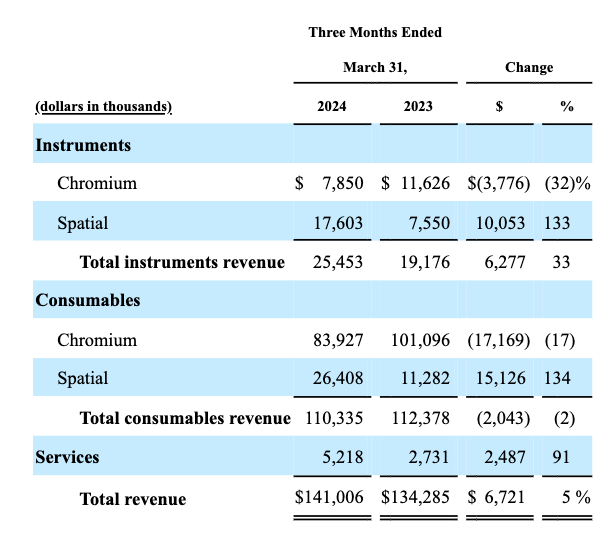Investment Overview
The share price of 10x Genomics, Inc. (NASDAQ:TXG) is down nearly 15% in early trading today, and is also down >70% year-to-date.
Pleasanton, California-based 10x is a “life sciences technology company focused on building innovative products and solutions to interrogate, understand and master biology,” according to its Q1 2024 quarterly report / 10Q submission, that offers “integrated solutions include instruments, consumables and software for analyzing biological systems at resolution and scale that matches the complexity of biology.”
The company discusses its products as follows:
Our commercial product portfolio leverages our Chromium X Series and Chromium Connect instruments, which we refer to as “Chromium instruments,” our Visium CytAssist, an instrument designed to simplify the Visium solution workflow by facilitating the transfer of transcriptomic probes from standard glass slides to Visium slides, and our Xenium Analyzer, an instrument designed for fully automated high-throughput analysis of cells in their tissue environment, which we refer to as “Spatial instruments,” and our proprietary microfluidic chips, slides, reagents and other consumables for our Chromium, Visium and Xenium solutions, which we refer to as “consumables.”
10x IPO’d in September 2019, raising $390 million at a price of $39, and during the period between October 2020 and January 2022 typically traded in a range between $150 – $200 per share, before suffering devastating losses throughout 2022, with the share price falling as low as $25 per share.
10x Genomic income statements (Seeking Alpha)
As we can see above, 10x’s revenues have actually shown impressive growth since IPO – up 20% year-on-year between 2022 and 2023, in fact. However, operating losses have also been increasing, with the company reporting a loss of $(195m) last year. Net income in 2023 was $(255m).
Illumina’s Move For Fluent Biosciences Responsible For TXG’s Today’s Losses?
It is unlikely a coincidence that 10x shares were falling today, as one of its main rivals in the gene sequencing space, Illumina, Inc. (ILMN), announced that it had acquired Fluent Biosciences, a “developer of an emerging and highly differentiated single-cell technology,” according to a press release. Illumina’s Chief Technology Officer Steven Barnard commented:
Single-cell research opens doors to new areas of discovery, and Fluent’s innovative, accessible, and flexible single-cell method will accelerate our ability to deliver full multiomics solutions for our customers.
10x’s Chromium single cell platform is its key revenue driver, responsible for ~$468m of revenues in 2023 (according to an investor presentation), which is ~75% of the company’s total revenues in 2023. As such, Illumina’s deal for Fluent must be setting alarm bells ringing on Wall Street, and among 10x’s senior management team.
Illumina has faced its difficulties recently, which I have discussed in a recent Seeking Alpha post, and its share price has fallen ~70% across the past 5 years. However, the company is the dominant force in the gene sequencing market, and has >$1bn in cash, and a quarterly R&D spend that is larger than 10x’s annual spend. Hence, in the coming years, Fluent may come to represent a major competitor to 10x’s business.
Heavy Q1 Losses & Litigation Contribute To Downward Spiral
At the end of April, 10x Genomics reported its Q1 2024 earnings. Revenues were up 5% year-on-year to $141m, with gross margin falling to 66%, from 73% in the prior year. Operating expenses came to $154.4m, up 3% year-on-year, and operating loss came to $(61.5m), up from $(52m) in the prior year. Net loss was $(59.9m), and cash position was reported as $372m.
While an ample cash position means that 10x is not in any immediate danger, it’s also clear that the current level of losses is unsustainable. Fortunately, the company has scarcely any debt, with total liabilities amounting to $204m.
The marketplace for products and services like those supplied by 10x can be tricky. The company operates a “razor and blade” business model in which revenues are divided between instruments sold / placed at research centers, hospitals, universities, commercial companies etc. and consumables sold that are used by the instruments when completing tests and processes.
10x Q1 2024 revenue breakdown (Q1 2024 10Q submission)
As we can see above, most of 10x’ revenues come from Cromium consumables, but these are also declining annually – at least in Q1. On the plus side, Spatial consumables revenues are growing, but not fast enough to offset losses. Obviously, the more instruments placed, the higher consumables revenues can reach, but 10x’s SG&A spend in Q1 was $86m – higher than the company’s R&D spend. Ideally, for a company like 10x, it would be better if the opposite were true. Margins are tight and growth therefore restricted.
When 10x announced its Q1 earnings, shares traded at ~$30 per share, but they continued to lose value, exacerbated by the fact a German court ruled against the company in May, in its patent dispute against another rival, NanoString.
10x had secured an injunction against Nanostring preventing the company from selling its CosMx Spatial Molecular Imager product as it infringed a 10x patent. However, that patent has now been declared invalid, and Nanostring says it will now seek an end to the injunction. To illustrate how tricky this industry can be, Nanostring, now part of Bruker Corporation (BRKR), had formerly declared itself bankrupt.
Looking Ahead – What Next For 10x Genomics?
The entire gene sequencing landscape looks bleak at present, primarily (in my view). This is owing to a lack of compelling use cases for sequencing products (we know the technology is valuable, but not precisely how it should be deployed yet). In addition, clients’ restricted budgets – hospitals, universities etc. – cannot afford to invest in niche products. Costs – both on the supplier side and the client side – are high. These are complex machines that require expensive parts and maintenance.
The share price of another sequencing company, Pacific Bio, is down >85% so far this year, and it appears that money is flowing out of the sector. Only Illumina’s size is preventing it from joining the bear market melee – at least so far.
10x launched its GEM-X product in February as a long-term replacement for its Chromium products, stating in a press release that:
GEM-X is built on a new and improved microfluidic chip design, featuring the latest technological advancements and optimized reagents for superior performance and high reliability.
On the Q1 2024 earnings call with analysts, however, management was subjected to intense questioning on whether the product would simply “cannibalize” sales of Chromium products, and how, that being the case, it could be a major revenue driver for the company? Softness in China, where sales were down >15% year-on-year, was another topic, as was pricing, and whether 10x would consider dropping prices to compete with the likes of Bruker, and Illumina.
To summarize, analysts took a look “under the hood” of 10x and did not seem to like what they saw. Management provided what is seemingly upbeat guidance, for $670m – $690m of revenues in 2024, up 8-12% year-on-year, albeit no guidance was provided for the bottom line.
At the time of writing, 10x’s market cap valuation is $1.9bn, so despite the 72% decline in its share price in the past year, this remains a valuable company. The market cap of PacBio is currently $357m, and that of Illumina, $18bn.
Unfortunately, based on recent events and looking ahead, I’d be inclined to believe 10x’s valuation is likely to fall closer to PacBio territory, rather than rising to challenge the likes of Illumina and Bruker Corporation, whose market cap is >$9bn.
I have covered multiple companies that market and sell relatively niche but technologically advanced life sciences or diagnostics products utilizing a razor and blade model. While I can think of few success stories, several failures spring to mind. Accelerate Diagnostics (AXDX), and T2 Biosystems in the diagnostics space, for example, Nano-X Imaging (NNOX), Bionano Genomics (BNGO), and we can also add to this list Pacific Bio, and Nanostring technologies, before its rescuing by Bruker.
The reality is that it is much easier to operate this type of business model if you are a life science giant like Thermo Fisher (TMO), Medtronic (MDT), or Abbott Technologies (ABT), for example, or indeed Illumina or Bruker.
These latter two companies may possess the financial muscle and infrastructure to make life very difficult for 10x, and to make matters worse, 10x sells its products without being able to guarantee clients any kind of return on investment.
Ultimately, it is up to clients to make valuable scientific discoveries that result in revenue streams opening up, and that makes 10x products a difficult pitch to any CFO at any establishment, whether academic, hospital, or private research agency.
Conclusion – After Today’s Drop, What Is The Call On TXG Stock?
As stated above, while I do not think 10x is in any immediate danger, the fate of Pacific Bio will doubtless be playing on investor’s minds. Illumina’s move to acquire Fluent Biosciences very likely puts it on a collision course with 10x’s most valuable products.
Throw in the fact that a rejuvenated Nanostring has won a notable victory in the courts that will allow it to resume selling its products in 10x’s markets, 10x’s sustained and heavy losses, and a dwindling funding runway, and it is difficult to point to too many positives for 10x at this time.
Doubtless, management will see things differently. They will be likely to show that GEM-X can be as successful product, deliver a blow-out revenues quarter to bring analysts back on side, and be a part of what it hopes will be an improving outlook for sequencing and life sciences research as the industry matures and new use-cases developed.
In the short-to-medium term, however, since I cannot point to specific or compelling reasons why the protracted bear run on 10x stock will end in this year, or next, I’d award shares a “sell” rating.
Unfortunately, this is a tough industry. Brilliant scientific innovation often goes unrewarded due to the pragmatic realities of research funding and budgetary constraints placed upon R&D centers. At this time, there are probably too many products challenging for a slice of a too small addressable market, and that seems unlikely to change for some years yet.
Read the full article here









Leave a Reply